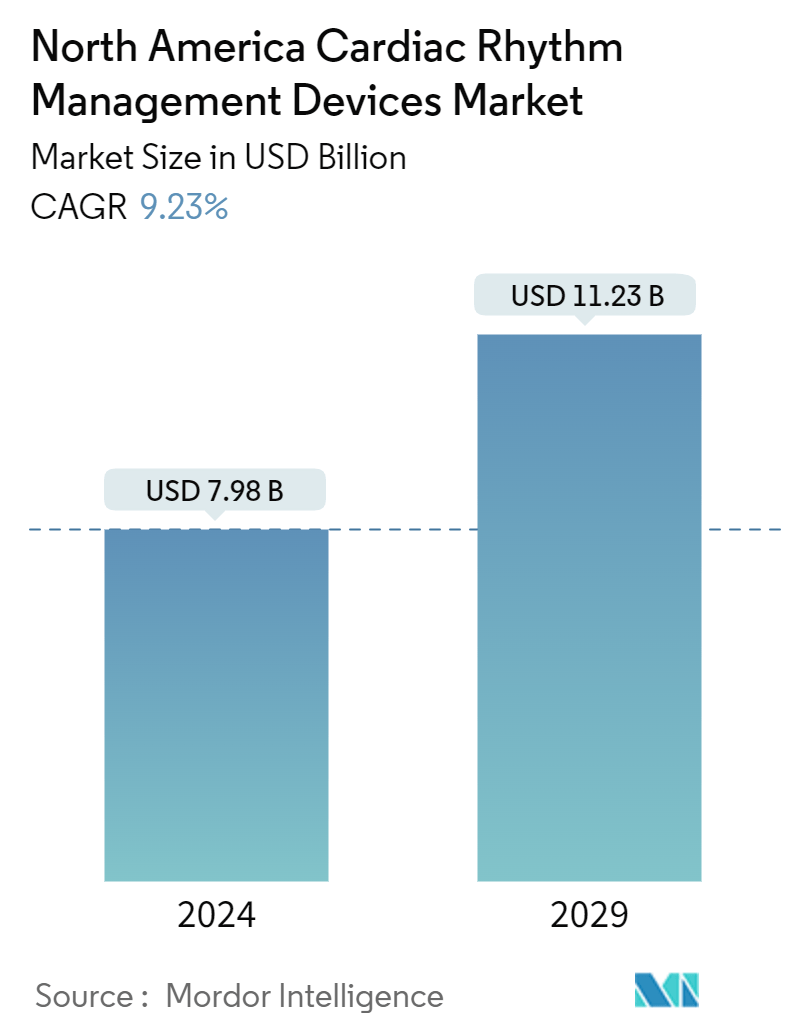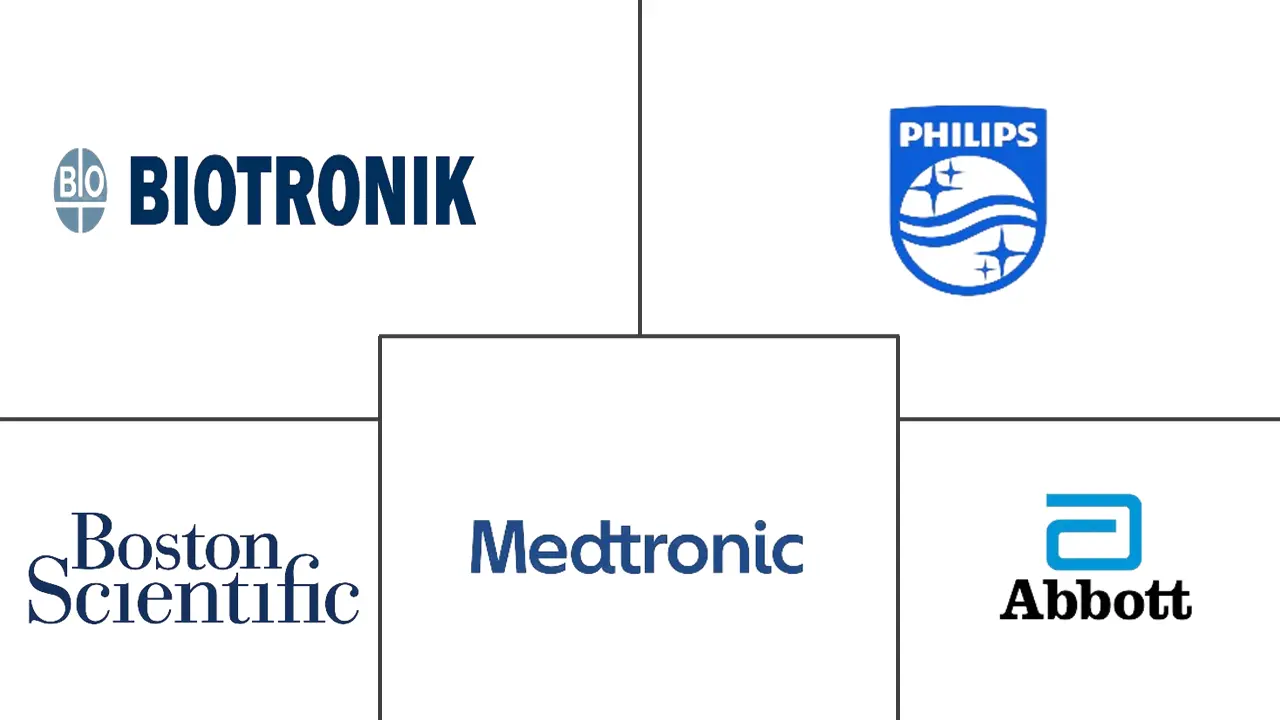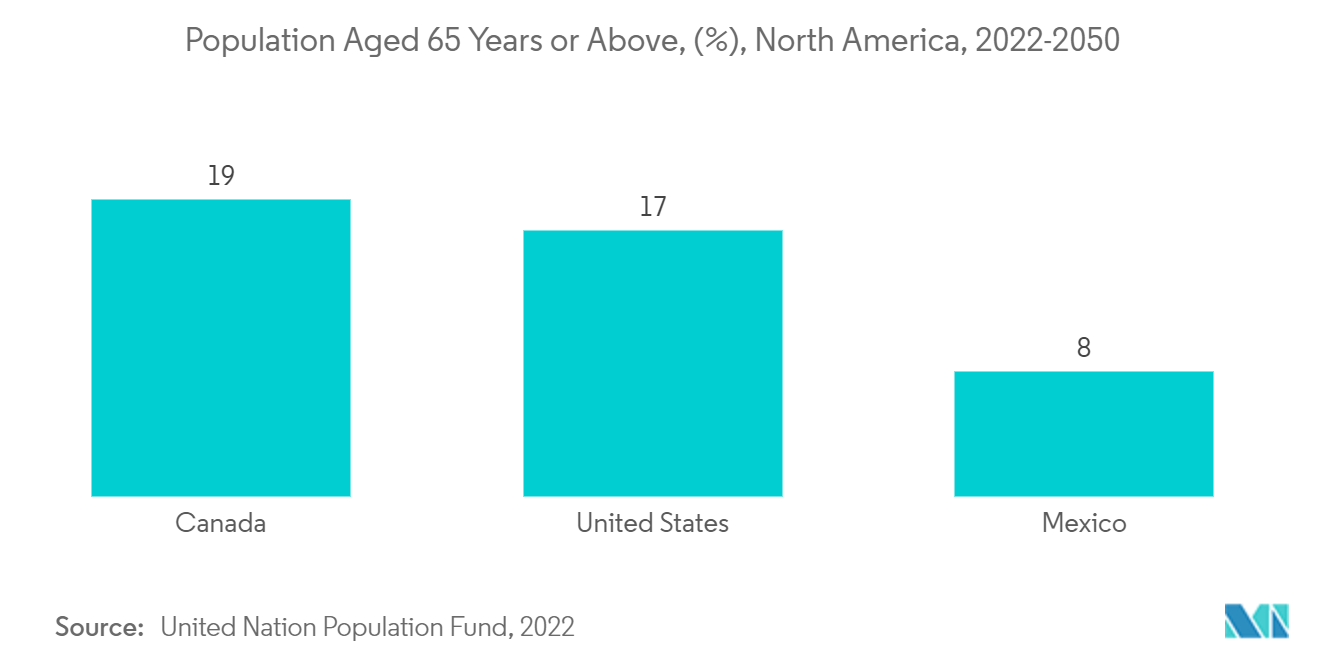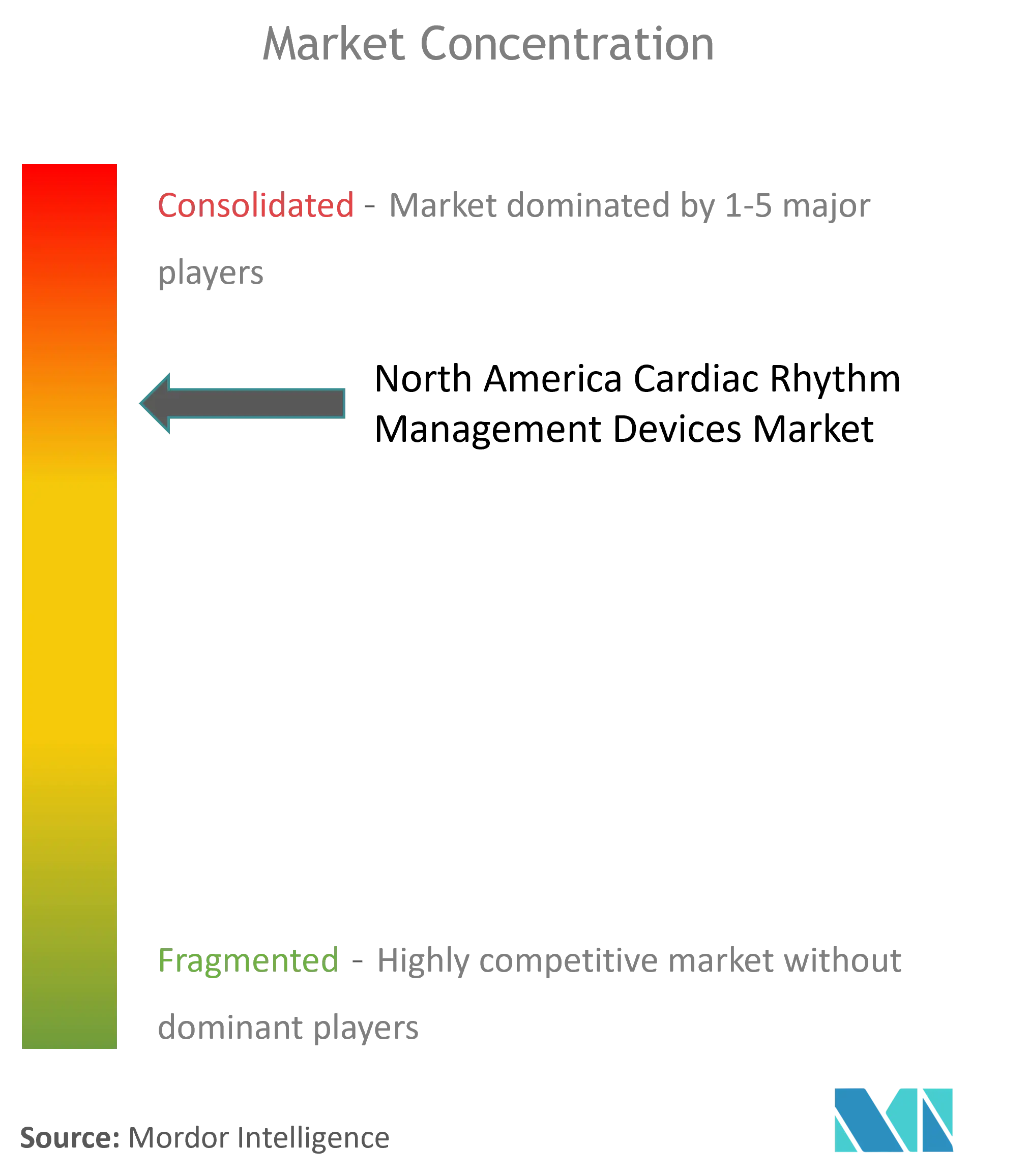North America Cardiac Rhythm Management Devices Market Size

| Study Period | 2019 - 2029 |
| Market Size (2024) | USD 7.98 Billion |
| Market Size (2029) | USD 11.23 Billion |
| CAGR (2024 - 2029) | 9.23 % |
| Fastest Growing Market | North America |
| Largest Market | North America |
| Market Concentration | High |
Major Players
*Disclaimer: Major Players sorted in no particular order |
North America Cardiac Rhythm Management Devices Market Analysis
The North America Cardiac Rhythm Management Devices Market size is estimated at USD 7.98 billion in 2024, and is expected to reach USD 11.23 billion by 2029, growing at a CAGR of 9.23% during the forecast period (2024-2029).
A cardiac rhythm management device is an implantable medical device that monitors or regulates the heart's electrical activity to treat various cardiac arrhythmias. These devices are used in several rhythm disorders, such as arrhythmia and other cardiovascular conditions.
Factors such as the surge in the burden of cardiovascular diseases, technological advancements in rhythm management devices, and the rise in the use of ambulatory and home services for cardiac monitoring are anticipated to expedite the market growth during the forecast period.
The increasing prevalence of cardiovascular diseases such as rhythm disorders and atrial fibrillation (AFib) are the major drivers projected to drive the market growth. For instance, according to April 2023 data from the Canadian Cardiovascular Society, atrial fibrillation (AFib) is one of the recurrent types of arrhythmia in clinical practice. It affects around 1% to 2% of the general population, and its risk increases with age.
In addition, according to an article published by the Journal of American Heart Association in April 2024, arrhythmia is a significant comorbidity in the adult congenital heart disease population in the United States. This leads to the high demand for cardiac rhythm management devices such as rhythm management devices, including defibrillators, as they are used to revive patients in an emergency by providing shock. This is anticipated to fuel the industry expansion during the forecast period.
In addition, the launch of awareness campaigns, various programs, and the launch of automated external defibrillator management platforms to promote the importance of fully automated external defibrillators are projected to contribute to the market growth. For instance, in April 2024, Essex-Windsor EMS launched a defibrillator awareness and mapping campaign in Canada. Under this campaign, Essex-Windsor EMS encourages business partners to install automatic defibrillators and promotes their adoption in an emergency.
Similarly, in June 2023, the Lexington Fire Department and the American Heart Association collaborated to launch the LEXSaveLives campaign to promote awareness and education regarding AED (automated external defibrillator) and CPR in the United States. Thus, such awareness and education campaigns are expected to fuel the adoption of rhythm management products in arrhythmia/cardiac arrest, which is anticipated to boost market growth during the forecast period.
The technological advancements in cardiac rhythm management devices, such as the introduction of implantable devices, are expected to drive industry growth in the region. Key players in the industry are undertaking various initiatives to strengthen their business, which will further contribute to the increased adoption of these devices during the forecast period. For instance, in June 2024, Stryker launched a LIFEPAK 35 monitor/defibrillator in the United States to provide life support in emergencies. The newly launched defibrillator is slim, lightweight, and has a portable design. Thus, introducing technologically advanced rhythm management products in North America will likely augment industry uptake during the forecast period.
Therefore, the market is anticipated to grow during the forecast period due to factors such as the high burden of cardiovascular diseases, growing company activities, and rising technological advancements. However, the high cost of devices and stringent regulatory framework about the safety of the products are further expected to impede market growth.
North America Cardiac Rhythm Management Devices Market Trends
The Implantable Pacemaker Segment is Expected to Witness Significant Growth During the Forecast Period
A pacemaker is a tiny device that uses electrical impulses implanted in the chest to regulate heartbeat. An implantable pacemaker is a sophisticated medical device designed to regulate and maintain a patient's abnormal heart rhythm by delivering controlled electrical impulses.
The implantable pacemakers (ICPS) segment is expected to witness significant growth in the market amid factors such as the growing burden of cardiovascular diseases (CVDs), technological advancements in implantable pacemakers, and increased demand for the implantable rhythm management system. In addition, several strategic initiatives undertaken by industry participants are further expected to foster segment uptake during the forecast period.
Technological advancements, such as the development of minimally invasive implantable pacemakers with extended battery life and enhanced features, are set to drive their adoption. This, in turn, is projected to fuel growth in the segment during the forecast period. For instance, according to an article published by Science Advances in October 2023, the development of a microtubular implantable pacemaker improved pacing and brought a non-invasive approach to rhythm management. Thus, such technological advancements in implantable pacemakers are likely to foster their adoption, which is anticipated to boost segment uptake over the coming years.
Moreover, the increased uptake of leadless implantable pacemakers across healthcare facilities is another factor projected to spur segment expansion over the coming years. For instance, in March 2024, UC San Diego Health successfully implanted the dual chamber leadless pacemaker to treat irregular heart rhythms. Thus, such an increased uptake of implantable pacemakers across healthcare settings is likely to foster their demand, which is anticipated to boost segment uptake during the forecast period.
Also, several strategic initiatives undertaken by industry participants to accelerate their business avenues are further expected to spur market growth. For instance, in July 2023, Abbott’s dual chamber (DR) leadless pacemaker system, AVEIR, was approved by the United States Food and Drug Administration (US FDA). The newly approved system treats people with abnormal heart rhythms and pacing. Such instances are likely to contribute to the segment expansion.
Therefore, the above-mentioned factors, such as technological advancements in implantable pacemaker technology, growing uptake of pacemaker implants in hospitals, and growing regulatory approvals, are expected to spur segment uptake during the forecast period.

The United States is Expected to Have the Significant Market Share During the Forecast Period
The United States is expected to hold a significant share in the cardiac rhythm management devices market during the forecast period owing to factors such as the high burden of cardiovascular diseases, increasing healthcare expenditure, increasing technological advancements, and growing demand for ambulatory or home services for cardiac monitoring.
The increasing prevalence of cardiovascular diseases is the key factor driving the demand for cardiac rhythm management devices in the country. For instance, according to January 2024 updated data of the American Heart Association, around 605,000 new heart attacks and 200,000 recurrent attacks occur every year in the United States.
In addition, according to the same source, coronary artery diseases, stroke, and heart failure are among the major affecting cardiovascular diseases in the United States. Thus, this profound increase in the burden of cardiovascular diseases in the United States is likely to create a significant demand for rhythm management devices, which, in turn, is anticipated to accelerate market growth during the forecast period.
Moreover, increasing initiatives by public and private organizations to promote awareness regarding cardiovascular diseases and several funding initiatives to accelerate the development of rhythm management products are likely to spur the country’s market growth during the forecast period. For instance, in April 2024, Avive Solutions Inc. raised funding of USD 56.5 million to foster the development of connected AED networks and transform the management of cardiac arrest emergencies. Thus, such funding initiatives are likely to facilitate the development of advanced products, which is expected to boost the country’s market growth during the forecast period.
Also, the increasing company emphasis on the adoption of various key strategies such as new product launches, acquisitions, collaborations, and regulatory approvals are further projected to contribute to the country’s market growth. For instance, in October 2023, the United States Food and Drug Administration (US FDA) approved Medtronic’s extravascular defibrillator to manage irregular heart rhythms and prevent sudden cardiac arrest.
In addition, the increased uptake of rhythm management systems in the United States is further expected to propel market growth. For instance, Hoag Memorial Hospital Presbyterian implanted a dual chamber leadless pacemaker, AVEIR DR of Abbott, in a patient. Such procedures will likely create a sustainable demand for novel products during the forecast period.
Therefore, the market is expected to grow during the forecast period due to the above-mentioned factors, such as the high burden of cardiovascular diseases and growing company activities.

North America Cardiac Rhythm Management Devices Industry Overview
The North American cardiac rhythm management devices market is consolidated and consists of a few major players. Key players operating in the market are launching advanced products to strengthen their business avenues in the North American market. Some of the key companies in the market include Abbott, Biotronik, Boston Scientific Corporation, Koninklijke Philips NV, Medtronic, SchillerAG, and Shenzhen Mindray Biomedical Electronics Co. Ltd.
North America Cardiac Rhythm Management Devices Market Leaders
-
Boston Scientific Corporation
-
Koninklijke Philips NV
-
Biotronik
-
Medtronic
-
Abbott
*Disclaimer: Major Players sorted in no particular order

North America Cardiac Rhythm Management Devices Market News
- March 2024: MicroPort CRM announced the implantation of the ALIZEA Bluetooth pacemaker system in the United States. Doctors of PIH Health Downey Hospital in California performed the procedure.
- June 2023: The Clemson University Fire & EMS Department (CUFD) and the Facilities Department collaborated to install automated external defibrillators on the University’s campus.
North America Cardiac Rhythm Management Devices Market Report - Table of Contents
1. INTRODUCTION
1.1 Study Assumptions and Market Definition
1.2 Scope of the Study
2. RESEARCH METHODOLOGY
3. EXECUTIVE SUMMARY
4. MARKET DYNAMICS
4.1 Market Overview
4.2 Market Drivers
4.2.1 Growing Burden of Cardiovascular Disorders
4.2.2 Technological Advancements
4.2.3 Rise in the Use of Ambulatory and Home Services for Cardiac Monitoring
4.3 Market Restraints
4.3.1 Stringent Regulatory Framework
4.3.2 High Cost of Devices
4.4 Porter's Five Forces Analysis
4.4.1 Threat of New Entrants
4.4.2 Bargaining Power of Buyers/Consumers
4.4.3 Bargaining Power of Suppliers
4.4.4 Threat of Substitute Products
4.4.5 Intensity of Competitive Rivalry
5. MARKET SEGMENTATION (Market Size by Value - USD)
5.1 Product
5.1.1 Defibrillators
5.1.1.1 Implantable Cardioverter Defibrillators (ICDS)
5.1.1.2 External Defibrillators (ED)
5.1.2 Pacemakers
5.1.2.1 Implantable Pacemakers (ICPS)
5.1.2.2 External Pacemakers
5.1.3 Cardiac Resynchronization Therapy Devices
5.1.3.1 Cardiac Resynchronization Therapy Defibrillators (CRT-D)
5.1.3.2 Cardiac Resynchronization Therapy Pacemakers (CRT-P)
5.2 Geography
5.2.1 United States
5.2.2 Canada
5.2.3 Mexico
6. COMPETITIVE LANDSCAPE
6.1 Company Profiles
6.1.1 Abbott
6.1.2 Stryker
6.1.3 Biotronik
6.1.4 Boston Scientific Corporation
6.1.5 Koninklijke Philips NV
6.1.6 MicroPort Scientific Corporation
6.1.7 Medtronic
6.1.8 SCHILLER
6.1.9 Shenzhen Mindray Biomedical Electronics Co. Ltd
6.1.10 ZOLL Medical Corporation (Asahi Kasei )
- *List Not Exhaustive
7. MARKET OPPORTUNITIES AND FUTURE TRENDS
North America Cardiac Rhythm Management Devices Industry Segmentation
As per the scope of the report, cardiac rhythm management is a part of electrophysiology, which is used to manage the functioning of the heart. The last decade has observed an ongoing evolution and the use of cardiac rhythm management devices, including cardiac resynchronization therapy, pacemakers, implantable cardioverter defibrillators, and loop recorders. General practitioners (GPs) are increasingly involved in the follow-up and management of patients with these devices.
The North American cardiac rhythm management devices market is segmented by product and geography. By product, the market is segmented into defibrillators, pacemakers, and cardiac resynchronization therapy devices. By geography, the market is segmented into the United States, Canada, and Mexico.
| Product | ||||
| ||||
| ||||
|
| Geography | |
| United States | |
| Canada | |
| Mexico |
North America Cardiac Rhythm Management Devices Market Research FAQs
How big is the North America Cardiac Rhythm Management Devices Market?
The North America Cardiac Rhythm Management Devices Market size is expected to reach USD 7.98 billion in 2024 and grow at a CAGR of 9.23% to reach USD 11.23 billion by 2029.
What is the current North America Cardiac Rhythm Management Devices Market size?
In 2024, the North America Cardiac Rhythm Management Devices Market size is expected to reach USD 7.98 billion.
Who are the key players in North America Cardiac Rhythm Management Devices Market?
Boston Scientific Corporation, Koninklijke Philips NV, Biotronik, Medtronic and Abbott are the major companies operating in the North America Cardiac Rhythm Management Devices Market.
Which is the fastest growing region in North America Cardiac Rhythm Management Devices Market?
North America is estimated to grow at the highest CAGR over the forecast period (2024-2029).
Which region has the biggest share in North America Cardiac Rhythm Management Devices Market?
In 2024, the North America accounts for the largest market share in North America Cardiac Rhythm Management Devices Market.
What years does this North America Cardiac Rhythm Management Devices Market cover, and what was the market size in 2023?
In 2023, the North America Cardiac Rhythm Management Devices Market size was estimated at USD 7.24 billion. The report covers the North America Cardiac Rhythm Management Devices Market historical market size for years: 2019, 2020, 2021, 2022 and 2023. The report also forecasts the North America Cardiac Rhythm Management Devices Market size for years: 2024, 2025, 2026, 2027, 2028 and 2029.
North America Cardiac Rhythm Management Devices Industry Report
Statistics for the 2023 North America Cardiac Rhythm Management Devices market share, size and revenue growth rate, created by Mordor Intelligence™ Industry Reports. North America Cardiac Rhythm Management Devices analysis includes a market forecast outlook to 2029 and historical overview. Get a sample of this industry analysis as a free report PDF download.



